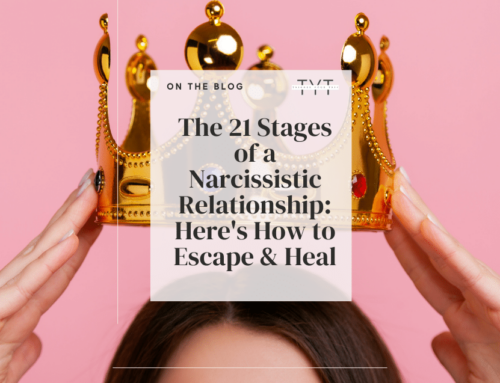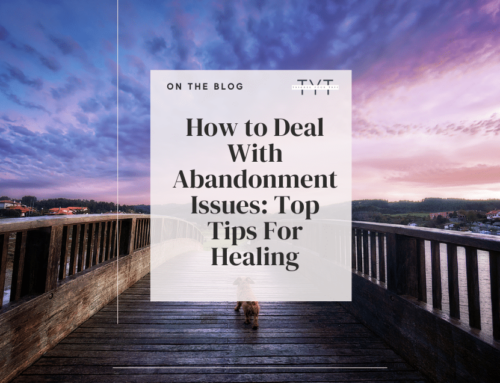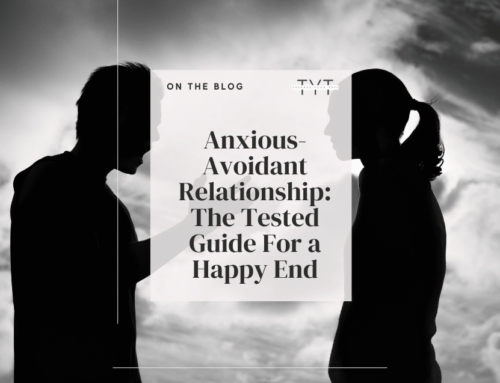Love can unravel our deepest fears, and in my journey of love, I’ve learned that it’s not always a smooth, unbroken road. My partner and I embarked on a beautiful yet complex journey of togetherness, where the ebbs and flows of our insecure attachment styles became the backdrop of our story. I thought he wasn’t ready for me, but the truth is, I wasn’t prepared to understand and deal with his avoidant attachment triggers.
Our love felt like an adventure, brimming with shared dreams, aspirations, and 4,000 miles that kept us apart. But as time passed, I began to discern a recurring pattern — a mysterious dance of emotional withdrawal and distance orchestrated by my partner’s avoidant attachment style. The closer I tried to get, the further he seemed to slip away.
By now, I know that I triggered him – yet I wish I had bumped into an article like this one when we were starting out. Therefore, I’ll share with you the most common avoidant attachment triggers and how to cultivate understanding and acceptance. I know first-hand the turbulent waters of loving a partner with a dismissive, avoidant attachment style; and I’m here to show you that it’s possible to navigate them.
Read More: The 7 Stages of Trauma Bonding; Here’s Why You Can’t Leave
About Dismissive Avoidant Attachment Style
The dismissive-avoidant attachment style, often referred to simply as the “dismissive” style, is characterized by a strong inclination towards self-sufficiency and relationship independence.
According to attachment theory, individuals with a dismissive avoidant attachment style tend to downplay the importance of emotional intimacy and may appear emotionally distant or aloof to their partners. This attachment style typically develops in childhood when caregivers consistently respond to a child’s needs by minimizing emotional expressions or encouraging self-reliance.
As a result, dismissive-avoidant individuals have difficulties in successfully maintaining healthy relationships. They learn to cope with attachment-related anxieties by suppressing their emotional needs and emphasizing self-reliance, often making their partners wonder why they don’t let them in.
In adult relationships, those with a dismissive attachment style often find expressing their feelings or needs challenging and threatening. They may prioritize personal space and independence, sometimes to the point of avoiding emotional intimacy altogether. While they may enjoy the benefits of companionship, they guard their autonomy fiercely.
Dismissive-avoidant individuals may perceive vulnerability and emotional dependence as signs of weakness, leading to difficulties forming deep, lasting bonds and healthy relationships. It’s important to note that dismissive attachment doesn’t mean they are incapable of love or affection; rather, they have developed unique strategies for managing their emotional connections that prioritize self-sufficiency and autonomy.
Read more: Fearful Avoidant Attachment: 7 Signs of Craving & Fearing Love
Do you have difficulty choosing a mental health professional? Can’t afford in-person couples or individual therapy?
This online therapy toolbox is more efficient and affordable than any other virtual therapy I’ve tried, including BetterHelp and Talkspace. It instantly matches you with a therapist and saves you hours of research for the right one (with unlimited daily messaging and support from your therapist). By leveraging the power of CBT (Cognitive Behavioral Therapy) -the most common psychotherapeutic approach for treating mental health problems- your therapist will guide you to a happier self through weekly sections, CBT worksheets, unlimited messaging, and daily worksheet replies. Bonus price for the fact that you can do your sessions wherever you are in the world and message your therapist anytime, daily.
What Are The Pains of Avoidant Attachment?
Individuals with a dismissive-avoidant attachment style often experience several emotional pains and challenges in their relationships due to their strong inclination towards self-reliance and emotional detachment. Here are some of the critical, painful aspects associated with this attachment style:
Emotional Suppression: Dismissive-avoidant individuals tend to suppress their emotions, leading to a lack of self-awareness and difficulty identifying and expressing their feelings.
Difficulty in Emotional Intimacy: They may struggle to form deep emotional connections with others, as they tend to keep their partners at arm’s length emotionally. This can lead to a sense of emotional loneliness and isolation.
Fear of Vulnerability: The idea of being vulnerable or dependent on someone else may trigger anxiety and discomfort, making it challenging to open up and seek support when needed.
Conflict Avoidance: Dismissive-avoidant individuals often avoid conflicts at all costs, leading to unresolved relationship issues, passive aggression, and ineffective communication.
Short-Lived Relationships: Their reluctance to fully invest emotionally in a relationship can result in shorter and less satisfying romantic relationships, as partners may feel neglected or unimportant.
Difficulty in Seeking Help: They may resist seeking therapy or support for relationship issues, believing they can handle their problems independently.
Loneliness: The pursuit of self-sufficiency can lead to loneliness and a fear of relying on others for emotional support.
Inability to Provide Emotional Comfort: While a securely attached person can successfully comfort their partner, those with an avoidant attachment may struggle to provide emotional support. That discomfort can be perceived as indifference from their partners, leading to frustration and dissatisfaction in their intimate relationships.
These traits and pains highlight the challenges that dismissive-avoidant individuals face in forming and maintaining healthy, fulfilling relationships. However, with self-awareness and effort, they can work towards developing a more secure attachment style.
Read More: The Best 25 Journal Prompts For Mental Health to Break Trauma
Why Do Avoidants Trigger Anxiety?
Avoidant individuals can easily trigger people with an anxious attachment style, as their emotional distance and occasional withdrawal activate the anxiously attached person’s fear of abandonment and need for constant reassurance. However, for several reasons, even those with a secure attachment style tend to experience anxiety when interacting with avoidants.
Inconsistency: Avoidants often exhibit inconsistent behavior, oscillating between emotional closeness and distance moments. This unpredictability can make secure individuals uncertain about their partner’s true intentions and emotional availability, causing anxiety.
Unresolved Conflicts: Avoidants’ tendency to avoid addressing conflicts or emotional issues can leave secure individuals feeling unheard or undervalued. The lack of open communication can create anxiety about the health and longevity of the relationship.
Emotional Disconnect: Avoidants’ reluctance to engage in deep emotional intimacy can leave secure individuals feeling disconnected or unfulfilled in the relationship. The absence of emotional sharing can trigger anxiety about the emotional depth of the connection.
Rejection Sensitivity: Secure individuals may be sensitive to the avoidant’s occasional distancing or need for personal space, interpreting it as rejection or lack of interest. This misinterpretation can lead to anxiety about the security of the relationship.
Desire for Emotional Connection: Secure individuals value emotional connection and may find it distressing when their dismissive avoidant partner seems resistant to engaging emotionally. This desire for connection can create anxiety when it feels unreciprocated.
In essence, avoidants’ patterns of behavior, characterized by emotional detachment and self-sufficiency, can clash with the secure individual’s preference for emotional closeness and open communication. This misalignment can result in anxiety as the secure partner navigates the challenges of maintaining a balanced and satisfying relationship with an avoidant partner.
Read More: How to Fix Anxious Attachment Style: The 9 Top Tested Strategies
What Are Some of The Deactivating Strategies For Avoidants?
A deactivating strategy is a behavior or coping mechanism to minimize emotional vulnerability and maintain emotional distance in relationships. Avoidant individuals often employ deactivating strategies to maintain self-reliance in relationships, especially when things have become too intimate for their standards. You can identify deactivating strategies by the following:
Emotional Suppression: Avoidants suppress or downplay their own emotions, making it challenging for others to connect with them on a deeper emotional level.
Independence Emphasis: They prioritize personal autonomy and self-sufficiency, which can lead to a reluctance to depend on others for support or closeness.
Minimizing Needs: Avoidants tend to minimize their own emotional needs, making it difficult for their partners to meet those needs or offer emotional support.
Avoiding Vulnerability: They avoid showing vulnerability or expressing deeper feelings to prevent potential rejection or emotional entanglement.
Distraction: Avoidants may distract themselves with work, hobbies, or other activities when emotional intimacy becomes too overwhelming or uncomfortable.
Withholding Information: They may withhold important information or feelings to maintain a sense of control and emotional distance in the relationship.
Physical Distance: Avoidants may create physical distance by avoiding physical contact, such as hugging or cuddling, to prevent emotional closeness.
Conflict Avoidance: They often avoid confrontations or disagreements, leading to unresolved issues and a lack of open communication in the relationship.
These deactivating strategies are mechanisms employed by avoidant individuals to protect themselves from emotional vulnerability and intimacy, which can create challenges in forming and maintaining satisfying relationships, especially with partners who have different attachment styles.
Read More: Intrusive vs Impulsive Thoughts: Differences, Causes & How to Manage
The 10 Most Common Avoidant Attachment Triggers
Intimacy and closeness
People with an avoidant attachment fear becoming emotionally dependent on others, potentially losing their autonomy. Their worry about being too close leads to discomfort when faced with intimate relationships’ emotional demands and potential entanglements.
Vulnerability
Vulnerability triggers people with an avoidant attachment because it makes them feel exposed and out of control, stirring up fears of potential rejection and emotional attachment, which challenges their preference for self-sufficiency and emotional distance in relationships.
Dependency
Dependency threatens the avoidant’s desire for autonomy and independence. They fear losing control and becoming overly reliant on others, leading to discomfort and anxiety when confronted with situations requiring support and emotional reliance in relationships.
Conflict
Conflict triggers people with an avoidant attachment because they fear emotional intensity and potential rejection in confrontational situations. They often prioritize maintaining emotional distance over resolving issues, leading to discomfort when faced with conflicts that demand emotional engagement and communication in healthy relationships.
Neediness
Neediness is one of the emotional triggers both for dismissive avoidant partners and fearful-avoidant ones. Neediness implies emotional dependency and a sense of being overwhelmed by someone’s demands, which goes against their insecure attachment style and desire for self-sufficiency and emotional distance. They fear losing control and being engulfed by the needs of others, leading to discomfort and anxiety in relationships.
Emotional expression
Emotional expression and good communication are some of the main traits of securely attached people, making avoidants run away. Emotional expression and constructive criticism in healthy relationships can make avoidants feel overwhelmed, vulnerable, and rejected, as, once again, expressing emotion threatens their autonomy. This discomfort can lead them to withdraw or distance themselves to regain a sense of control and independence.
Loss of independence
Loss of independence is not the same as intimacy, closeness, or dependency. Loss of independence happens when the avoidant actively chooses to commit by either living, marrying, or engaging with a partner. It’s not uncommon to suddenly see them getting cold feet, making their romantic partner wonder what went wrong.
Rejection
Rejection triggers avoidants due to their underlying fear of abandonment. They may perceive rejection and personal criticism as confirmation of their unworthiness or a threat to their emotional independence. To protect themselves from this vulnerability, they may withdraw or distance themselves from situations that could potentially lead to rejection. I remember my partner saying, “I’m too good for you.” and “What’s the point of trying? You can find multiple partners in your country.”, always so sure I’ll reject him that he didn’t even consider trying to commit.
Trust issues
As mentioned, avoidants have difficulties relying on others and often doubt their intentions. If you show them that you don’t trust easily, you intensify their fear that they might let you down or betray you. They build emotional distance to protect themselves from potential disappointment, making trust-building even more challenging in their relationships.
Read More: The 150 Top Shadow Work Prompts to Unblock Your Potential
How to Handle Avoidant Attachment Triggers
Handling avoidant attachment triggers and making someone with an avoidant attachment style desire physical closeness and feel safe requires patience, understanding, and effective communication. Here are five strategies:
- Create a Secure Environment:People with an anxious attachment style might threaten, pressure, or try to make their avoidant partners jealous when they withdraw. Thus, you should avoid these behaviors and instead:
- Foster an environment where open communication is encouraged and emotional expression is accepted without judgment.
- Demonstrate reliability and consistency in your actions and words to build trust over time.
- Respect Boundaries:People with avoidant attachment want to commit while also maintaining their solitude. Therefore:
- Recognize and respect their need for personal space and independence with appropriate boundaries – and without sacrificing your own desires. If there is a desire mismatch, discuss it.
- Allow them to initiate closeness and emotional intimacy at their own pace.
- Effective Communication:
- Practice active listening and empathy to understand their concerns and feelings.
- Encourage them to express their emotions and thoughts without pressure, criticism, or judgment. Try to make them understand that expressing unpleasant emotions is an essential skill.
- Build Emotional Safety:
- Be patient and understanding if the avoidant attachment style of your partner makes them withdraw. Give them space if needed, but let them know you’re there for support.
- Reassure them of your commitment and loyalty in the relationship to reduce their fear of abandonment. You can express emotions while building a relationship gratitude list to calm their inner critic.
- Therapeutic Support:
- Consider couples or individual therapy, especially if the emotional volatility of the avoidant partner significantly impacts the relationship.
- Make them see how a therapist can provide guidance and tools for both partners to navigate healthy self-regulation and attachment-related challenges effectively.
Read More: How Much Is Couples Therapy? (With Best Virtual Alternatives)
Summing up
Understanding and addressing avoidant attachment triggers can be pivotal in cultivating healthier, more secure relationships. By recognizing and empathizing with the emotional complexities underlying these triggers, we can build bridges of trust and intimacy with avoidant partners. Patience, effective communication, and creating a secure environment for emotional expression are key.
Ultimately, it’s a journey of mutual growth and connection, one where the challenges posed by these triggers can be transformed into opportunities for deeper understanding and enduring love. Through empathy and shared effort, we can navigate the intricate dance of avoidant attachment triggers, fostering stronger and more fulfilling bonds in the process.






